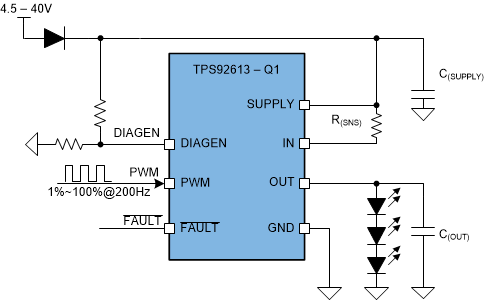SLVSEC4B April 2019 – January 2020 TPS92613-Q1
PRODUCTION DATA.
- 1 Features
- 2 Applications
- 3 Description
- 4 Revision History
- 5 Pin Configuration and Functions
- 6 Specifications
- 7 Detailed Description
- 8 Application and Implementation
- 9 Power Supply Recommendations
- 10Layout
- 11Device and Documentation Support
- 12Mechanical, Packaging, and Orderable Information
Package Options
Mechanical Data (Package|Pins)
- NDR|7
Thermal pad, mechanical data (Package|Pins)
Orderable Information
7.3.3 PWM Control
The pulse width modulation (PWM) input of the TPS92613-Q1 functions as enable for the output current. When the voltage applied on the PWM pin is higher than VIH(PWM), the output current is enabled. When the voltage applied on PWM pin is lower than VIL(PWM), the output current is disabled as well as the diagnostic features. Besides output current enable and disable function, the PWM input of TPS92613-Q1 also supports adjustment of the average current output for brightness control if the frequency of applied PWM signal is higher than 100 Hz, which is out of visible frequency range of human eyes. TI recommends a 200-Hz PWM signal with 1% to 100% duty cycle input for brightness control. See to Figure 20 for typical PWM dimming application.
 Figure 20. Typical Application Schematic for PWM Dimming
Figure 20. Typical Application Schematic for PWM Dimming